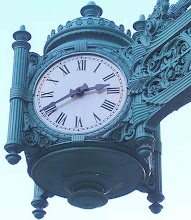One of the delights of exploring department store history is learning which traditions are most cherished by customers and employees.
In talking with people and reviewing books and articles about Marshall Field’s, certain favorite traditions emerge as the standouts. In my unscientific assembling, the top 10 favorite traditions are:
10. Uncle Mistletoe. What's not to love about a Christmas character who looked like he stepped right out of a Dickens novel, encourages kids to join the Kindness Club, and has eyebrows that resemble small boats?
9. Marshall Field's Special Sandwich. A huge hunk of iceberg lettuce, some chicken and neon Thousand Island Dressing. A Classic, even if hasn't appeared on a menu for years.
8. The 3rd floor book department. This is the dept. that
started book signings and hosted everyone from Shirley Temple to Admiral Byrd to Amelia Earhart. For a while, the biggest book dept. in the world (or so Field's always said)
7. The 8th floor Trend House. A ground-breaking idea for its time -- an entire house set up on the 8th floor, changed about twice a year and featuring fully decorated rooms. Originally the furnishings were affordable and the looks something ordinary people might want, but gradually it drifted into the outrageously trendy and outrageously pricey.
6. The 4th floor children's dept, especially the toy and game dept. At one time, the largest toy dept in the world (again, in Field's own unbiased words) and full of exclusives, like Field's own Madame Alexander dolls and Marshall Field's green Tonka trunks.
5. The Great Clock. According to legend, established so people would have a convenient place to meet. The original clock at State and Washington was replaced when the new store building went up. And a mate was installed at State and Wabash (in the new building that actually opened prior to the one at State and Washington). Designed by Daniel Burnham's firm, which also did the building, and slated for memoralization in a Saturday Evening Post cover by Norman Rockwell. For some reason, the clock at Washington St. became more famous than the one at Wabash -- and both more famous than virtually any other clock in Chicago.
4. The Tiffany mosaic glass dome. Still the largest individual piece of irridescent glass mosaic ever installed. When it opened, as part of the new building's opening in 1907, president John G. Shedd worried that the floor under the dome might not hold up under the weight of the throngs who came to see the dome.
3. Frango mints. Chocolate. Mint. Delicious. Not a Field's original (acquired with the acquisition of the legendary Frederick and Nelso Dept. store in 1929) but Field's made it its own, producing it for years on the flagship store's 13th floor. Field's perpetuated the wonderful legend that they were originally called Franco's but were renamed when the Spanish dictator rose to power. Sadly, patent application papers reveal that the name Frango was registered in 1918, long before anyone heard of Generalissimo Franco.
2. The Great Tree in the Walnut Room. Originally a 45-foot real tree hauled up the light well and monitored by firefighters, but for most of its history an artificial -- but splendid tree rising several stories high. Eating lunch or having tea under the Great Tree became such a tradition for Chicago families that many children's memories include the hours and hours -- and hours -- of waiting until a table openedup.

1. The Christmas holiday windows. Marshall Field's was not the first department store to put up Christmas window displays, but like so many other things, the Field's windows came to feel like the best in Chicago.
Ok, maybe nothing earth-shattering here, but think about this:
On this list, 5 of the 10 are not directly related to buying. The Christmas windows, the Tiffany dome, the Great Clocks -- not things you came to purchase, but rather the delightful, lavish displays that drew you to the store and made experiencing it a one-of-a-kind, special indulgence. They marked a visit to the store as something opulent and luxurious. They were part of the “feel” of the store, the emotional whallop a visit to it delivered.
 My mother (who will hate me because she hates seeing photos of herself but I think she looks great) and my darling niece Annie.
My mother (who will hate me because she hates seeing photos of herself but I think she looks great) and my darling niece Annie.




